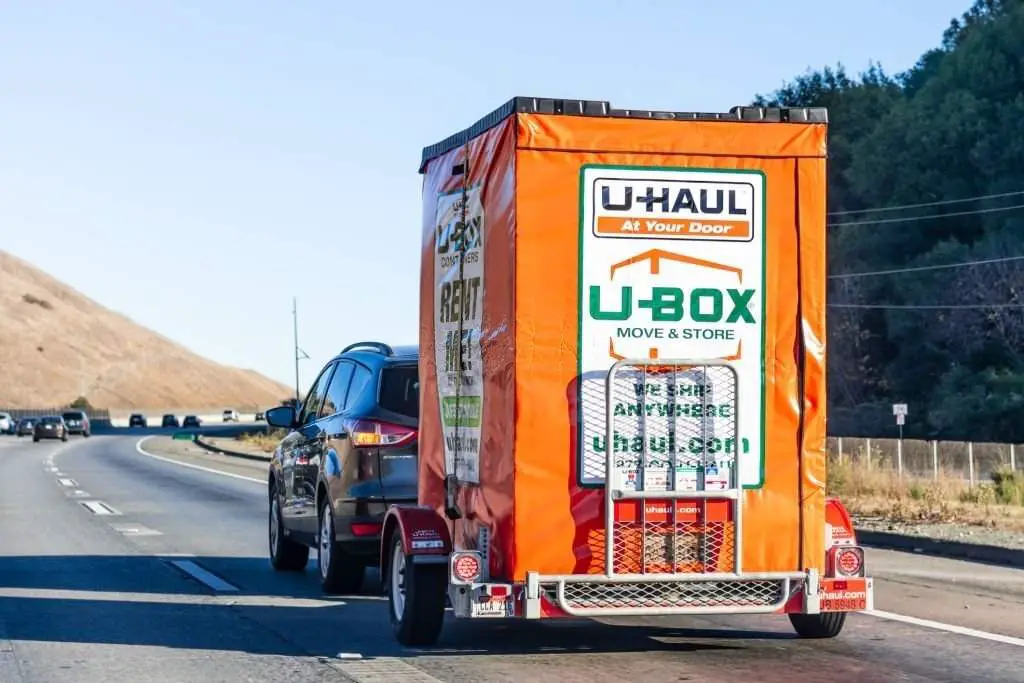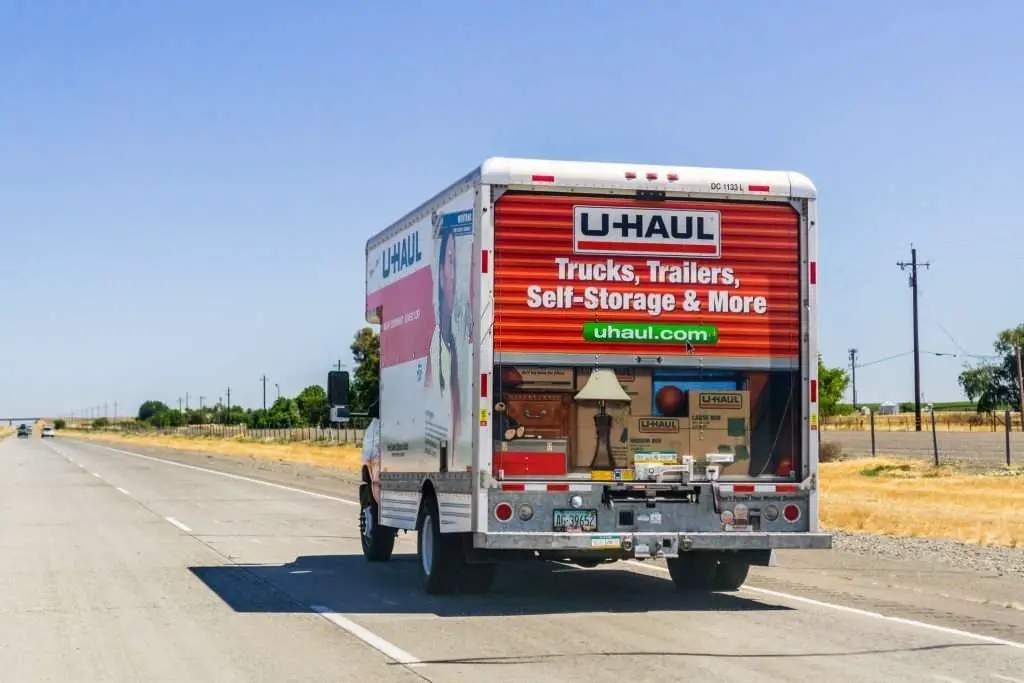The U-Haul company was founded back in 1945 in Ridgefield, Washington. Today it boasts over 21,000 locations, making it the largest truck rental company in the United States. If you’re thinking of renting a U-Haul truck, it’s a good idea to first interpret how much weight it can hold.
U-Haul’s smallest vehicle—the pick-up—has a maximum load weight of 2,280 pounds (1034 kg), whereas U-Haul’s largest box truck can manage 12,859 pounds (5833 kg).The company currently has 7 different trucks on offer, and the amount of weight each truck can hold depends on the size of the truck.
Each vehicle also comes with a maximum towing capacity, which you should include as part of the maximum load weight. Keep reading to discover how much each truck can hold, tips for weight-loading a U-Haul, and how to drive with a fully loaded truck.

Breaking Down the Maximum Load Weight for Each U-Haul Truck
U-Haul is very keen on making sure you rent the right truck for your move. Indeed, the company doesn’t want moving your stuff from one place to the next to be any more complicated than necessary.
So let’s look at a table showing the weight limits for U-Haul’s 7 trucks:
| Truck | Size | Maximum Load Weight |
| Pick-ups | 4,474 lb (2029 kg) empty | 2,280 lb (1034 kg) |
| 9’ (274 cm) Cargo Vans | 4,985 lb (2261 kg) empty | 4,030 lb (1828 kg) |
| 10’ (305 cm) Box Truck | 5,790 lb (2626 kg) empty | 2,850 lb (1293 kg) |
| 15’ (457 cm) Box Truck | 8,115 lb (3681 kg) empty | 6,385 lb (2896 kg) |
| 17’ (518 cm) Box Truck | 8,340 lb (3783 kg) empty | 6,160 lb (2794 kg) |
| 20’ (609 cm) Box Truck | 8,800 lb (3992 kg) empty | 5,700 lb (2585 kg) |
| 26’ (792 cm) Box Truck | 13,140 lb (5960 kg) empty | 12,859 lb (5833 kg) |
Don’t be overwhelmed. U-Haul’s website provides all of this data, plus sample moving jobs for each truck. For instance, the little pick-ups are good for hauling things like lawnmowers—the push kind—garden equipment, and tools, whereas the 26’ (792 cm) box truck is for full-on furniture moves of 3 bedroom homes.
So now you have a pretty good idea of how much weight each moving truck can hold. Lining up the numbers should be pretty easy. How to arrange all that weight is easy, too, as the following section demonstrates.
U-Haul Weight Loading Tips
Whether you’ve rented a smaller truck or one of the big monsters, you’ve got stuff to haul (unless you’re just trying to make the neighbors think you’re going to move). How you arrange that stuff in the back of the truck can mean the difference between triumph and travesty.

Here are some tips on how to load a U-Haul rental:
- Put the heaviest items in front. (Load these items right behind “Mom’s Attic,” an additional part of the U-Haul truck specifically designed for protecting delicate stuff.)
- Don’t leave spaces for items to shift around.
- Tie everything off in what U-Haul calls “tiers and cells.”
- Distribute the weight as evenly as possible.
“Mom’s Attic” and Loading Heaviest Items in Front
Larger U-Haul trucks have a section the company calls “Mom’s Attic”. Mom’s Attic is a storage area above the cab. Since the attic is at the front of the truck, you’ll be loading here first. It’s a smooth ride in Mom’s world, so use it for delicate items such as glass and electronics.
Bulky, heavy items should be loaded onto the truck next. Not only does this get the difficult part of the job out of the way early, but the truck will handle better—and more safely—on the road. Heavy stuff includes couches, mattresses, your grandpa’s old recliner, and the China cabinet. Don’t break anything—or if you do, have a good story ready for your wife.
Keep Items From Shifting Around
One of the most hideous sounds in the world is that of something tipping over in the back of a moving truck. When it happens, the driver and the passenger give each other a look unsuitable for this narrative’s description.
Load items in tiers based on their weight. For instance, all the heavy stuff should be in front, the medium-sized stuff in the middle, and the light-weights in the back. Tie each section off with moving straps.
U-Haul offers some helpful amenities to prevent shiftings, such as packing tape, packing paper, and furniture pads. Keeping stuff from falling over makes the truck more stable on the road.
Driving Habits for Fully Loaded U-Haul Trucks

Some drivers get a bit skittish behind the wheel of a moving truck. Guess what? This is precisely the way it should be.
Driving a fully loaded U-Haul truck isn’t difficult so long as the necessary precautions—such as proper loading and being extra attentive to the traffic laws—are taken.
Here are some things to keep in mind during your big move:
- Drive slower than you usually would
- Give yourself extra stopping time
- Make your turns wider
- Avoid the passing lane whenever possible
All U-Haul trucks come with automatic transmissions, so you won’t need to worry about clutching and shifting. What driving a fully loaded moving truck boils down to is taking things extra slow. Also, don’t overload the truck.
The Dangers of Overloading a U-Haul Truck
There are state and federal regulations against overloading a moving truck. These regulations only make sense, because operating a truck beyond its load capacity endangers the lives of you and other people on the road.
Overloaded U-Haul trucks can take too long to brake—or worse, not be able to brake at all. Too much weight in the cargo area also puts more strain on the tires, increasing the risk of a blowout. Even if overloading doesn’t get you into an accident, the truck will use more gas and oil than normal. Always follow U-Haul’s guidelines for their moving truck weight capacity.
Conclusion
Today’s U-Haul trucks are tough enough to handle some big loads. Then again, every machine has its limits. On the day of your rental, make sure the agent knows how big the move is going to be. This way they will have no trouble recommending the right-sized truck for you.
Related Posts:
